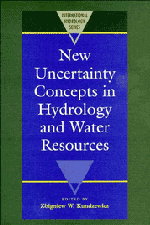Book contents
- Frontmatter
- Contents
- List of Authors
- Preface
- I INTRODUCTION
- II FACETS OF UNCERTAINTY
- III NOVEL APPROACHES TO UNCERTAINTY: FRACTALS, FUZZY SETS AND PATTERN RECOGNITION, NON-PARAMETRIC METHODS
- IV RANDOM FIELDS
- V TIME SERIES AND STOCHASTIC PROCESSES
- VI RISK, RELIABILITY AND RELATED CRITERIA
- 1 Stochastic approach to non-point pollution of surface waters
- 2 Statistically safe sets methodology for optimal management of reservoirs in risk situations
- 3 Risk assessment in control of reservoir systems
- 4 Reliability-related criteria in water supply system studies
- 5 Reliability analysis of reservoir operation
2 - Statistically safe sets methodology for optimal management of reservoirs in risk situations
Published online by Cambridge University Press: 07 May 2010
- Frontmatter
- Contents
- List of Authors
- Preface
- I INTRODUCTION
- II FACETS OF UNCERTAINTY
- III NOVEL APPROACHES TO UNCERTAINTY: FRACTALS, FUZZY SETS AND PATTERN RECOGNITION, NON-PARAMETRIC METHODS
- IV RANDOM FIELDS
- V TIME SERIES AND STOCHASTIC PROCESSES
- VI RISK, RELIABILITY AND RELATED CRITERIA
- 1 Stochastic approach to non-point pollution of surface waters
- 2 Statistically safe sets methodology for optimal management of reservoirs in risk situations
- 3 Risk assessment in control of reservoir systems
- 4 Reliability-related criteria in water supply system studies
- 5 Reliability analysis of reservoir operation
Summary
ABSTRACT The paper concerns the problems of optimal control of reservoirs when subsequent inflows are represented as independent random variables of known distributions or the Markov chains, and apart from performance index other control goals are present. They may have the form of chance constraints or constraints on the expected value of certain functions of stage variables (i.e., controls or states in given periods). A method of conversion of the global constraints to the stage ones is also presented. The statistically safe sets methodology is explained on the background of other methods of determining reservoir control strategies such as linear decision rules, reliability programming, penalty function method or the method of the Lagrange multipliers.
INTRODUCTION
For many years the specialists in designing control algorithms for water reservoirs have agreed that the problems of risk connected with uncertainty of inflows are of primary importance. It is almost impossible to enumerate all techniques proposed in the literature. The models that account risk through imposing lower constraints on the probability of desirable events and upper constraints on the probability of undesirable events (so-called ‘reliability’ or ‘chance’ constraints) are most popular. These events may be considered in any given period, a specific control horizon or during the entire life of the system.
The ‘reliability’ or ‘chance’ constraints define an admissible area in which the optimal release curve, maximizing or minimizing an objective function, is sought. Sometimes they are replaced with constraints on expected value of some variables or functions.
- Type
- Chapter
- Information
- New Uncertainty Concepts in Hydrology and Water Resources , pp. 284 - 292Publisher: Cambridge University PressPrint publication year: 1995

